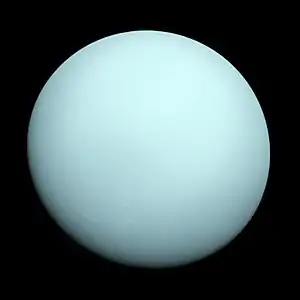Francisco (moon)
Francisco is the innermost irregular satellite of Uranus.
| Discovery | |
|---|---|
| Discovered by | |
| Discovery date | August 13, 2001[1][2] (confirmed in 2003[1][3]) |
| Designations | |
Designation | Uranus XXII |
| Pronunciation | /frænˈsɪskoʊ/[4] |
| Adjectives | Franciscan, Fransiscian, Francisconian |
| Orbital characteristics | |
Mean orbit radius | 4,276,000 km[5][6] |
| Eccentricity | 0.1459[6] |
| 266.56 d | |
| Inclination | 145° (to the ecliptic)[5] |
| Satellite of | Uranus |
| Physical characteristics | |
Mean radius | 11 km (estimate)[7] |
| ~1,500 km2 (estimate) | |
| Volume | ~6,000 km3 (estimate) |
| Mass | ~7.2×1015 kg (estimate) |
Mean density | ~1.3 g/cm3 (assumed) |
| ~0.0025 m/s2 (estimate) | |
| ~0.0094 km/s (estimate) | |
| ? | |
| ? | |
| Albedo | 0.04 (assumed)[7] |
| Temperature | ~65 K (estimate) |
Francisco was discovered by Matthew J. Holman, et al. and Brett J. Gladman, et al. in 2003 from pictures taken in 2001 and given the provisional designation S/2001 U 3. Confirmed as Uranus XXII, it was named after a lord in William Shakespeare's play The Tempest.[8]

Animation of Sycorax's orbit around Uranus.
Uranus
Sycorax
Francisco
Caliban
Stephano
Trinculo
Uranus
Sycorax
Francisco
Caliban
Stephano
Trinculo
See also
References
- Green, Daniel W. E. (2003-10-07). "IAUC 8216: S/2001 U 3". IAU Circular. Retrieved 2011-01-08.
- Blue, Jennifer (2008-10-16). "Planet and Satellite Names and Discoverers". Working Group for Planetary System Nomenclature (WGPSN). Retrieved 2008-12-19.
- Sheppard, Scott S. "New Satellites of Uranus Discovered in 2003". Institute for Astronomy at the University of Hawaii. Archived from the original on January 16, 2009. Retrieved 2008-12-19.
- Benjamin Smith (1903) The Century Dictionary and Cyclopedia
- Sheppard, Jewitt & Kleyna 2005, p. 523, Table 3.
- Jacobson, R.A. (2003) URA067 (2007-06-28). "Planetary Satellite Mean Orbital Parameters". JPL/NASA. Retrieved 2008-01-23.
- Sheppard, Jewitt & Kleyna 2005, p. 523, Table 3 ... ri (km) ... 11 ... i Radius of satellite assuming a geometric albedo of 0.04.
- "Planet and Satellite Names and Discoverers". Gazetteer of Planetary Nomenclature. USGS Astrogeology. July 21, 2006. Retrieved 2006-08-06.
- Sheppard, S. S.; Jewitt, D.; Kleyna, J. (2005). "An Ultradeep Survey for Irregular Satellites of Uranus: Limits to Completeness". The Astronomical Journal. 129 (1): 518–525. arXiv:astro-ph/0410059. Bibcode:2005AJ....129..518S. doi:10.1086/426329. S2CID 18688556.
External links
This article is issued from Wikipedia. The text is licensed under Creative Commons - Attribution - Sharealike. Additional terms may apply for the media files.


